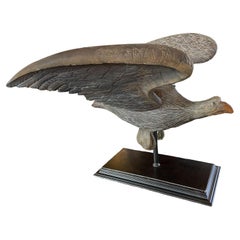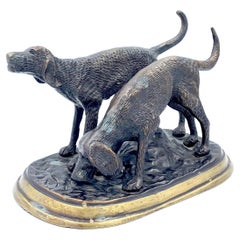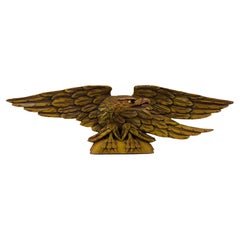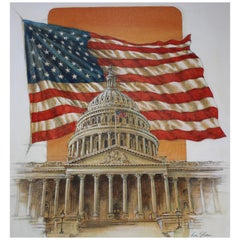Want more images or videos?
Request additional images or videos from the seller
1 of 6
"Defiant Comanche" Mixed Media Sculpture by Chris Pardell
$1,500List Price
About the Item
- Dimensions:Height: 14 in (35.56 cm)Width: 6.5 in (16.51 cm)Depth: 5 in (12.7 cm)
- Materials and Techniques:
- Period:1990-1999
- Date of Manufacture:1991
- Condition:Wear consistent with age and use. Mixed-media sculpture with bronze, copper, pewter. Colorized. No noticeable damage.
- Seller Location:Colorado Springs, CO
- Reference Number:Seller: OT4171stDibs: LU909724690502
About the Seller
4.9
Vetted Professional Seller
Every seller passes strict standards for authenticity and reliability
Established in 2010
1stDibs seller since 2011
464 sales on 1stDibs
Authenticity Guarantee
In the unlikely event there’s an issue with an item’s authenticity, contact us within 1 year for a full refund. DetailsMoney-Back Guarantee
If your item is not as described, is damaged in transit, or does not arrive, contact us within 7 days for a full refund. Details24-Hour Cancellation
You have a 24-hour grace period in which to reconsider your purchase, with no questions asked.Vetted Professional Sellers
Our world-class sellers must adhere to strict standards for service and quality, maintaining the integrity of our listings.Price-Match Guarantee
If you find that a seller listed the same item for a lower price elsewhere, we’ll match it.Trusted Global Delivery
Our best-in-class carrier network provides specialized shipping options worldwide, including custom delivery.You May Also Like
Pair of Bronze Stirrups 'Estribos'
Located in Saint-Ouen, FR
Pair of Bronze stirrups (Estribos), 19th century.
Measures: H: 14 cm, W: 29 cm, D: 11 cm.
Category
Antique 19th Century European Sculptures and Carvings
Materials
Bronze
Acrylic and Paper / mixed media sculpture by Sam Russo, W N Y Artist
By Russo
Located in Buffalo, NY
Circa 1970 acrylic / paper sculpture signed by WNY artist Sam Russo (b.1922) and titled “Objects”. Russo was a well established artists with works in the permanent collections of bot...
Category
Vintage 1970s American Mid-Century Modern Sculptures and Carvings
Materials
Acrylic, Lucite, Paper
$2,190
H 16.38 in W 13.38 in D 3 in
Folk Art Primitive Hand-Carved Bull
Located in Los Angeles, CA
Primitive hand-carved Folk Art bull made of wood. Great hand work and scale. One Horn has a chip. Great sculptural piece.
Category
Vintage 1970s American Sculptures and Carvings
Materials
Wood
Mexican Folk Art Wood Carving Traditional Dance Handmade Alebrije One of a Kind
By Manuel Cruz Prudencio, Ruby Fabian
Located in Queretaro, Queretaro
The young dancers wear an armor of threads over their bodies, showing off an ancient indigenous art form. Colorful thread combinations characterize the huipil dress, a rectangle of cloth handwoven on a backstrap loom that dates back thousands of years in used in Zapotec culture. Through symbols in their dresses, Zapotec women wear their identity, history, culture, power, social and marital status, religion, personality, and power.
In this folkloric dance, “Flor de Piña” (Pineapple Flower), innocence surrounds young girls as they dance and hold pineapples on their shoulders as an offering. Their long braids represent purity and their bare feet symbolize their connection to the Earth.
This folkloric dance is part of the “Guelaguetza” (name in the indigenous Zapotec language) Festival Celebration. Since pre-hispanic times, the indigenous people of Oaxaca have honored the goddess of maize with this festival, performing and offering gifts to ensure a good harvest.
Husband and wife, master woodcarver Manuel Cruz and wood painter...
Category
21st Century and Contemporary Mexican Folk Art Sculptures and Carvings
Materials
Acrylic, Wood
$3,200
H 14.97 in W 14.97 in D 6.3 in
Cow Bull Folk Art Speculaas Springerle Cookie or Butter Mold Antique, German
Located in Nuernberg, DE
Classic late 19th century wooden gingerbread cookie or speculaas springerle mold, circa 1890 (cow bull ox). Made of hand carved wood. Found at an esta...
Category
Antique Late 19th Century Austrian Folk Art Sculptures and Carvings
Materials
Wood
$162 Sale Price
40% Off
H 3.25 in W 7.88 in D 0.5 in
19th Century Nobleman Wooden Gingerbread Cookie Speculaas Springerle Mold
Located in Nuernberg, DE
Classic 19th century wooden gingerbread cookie or speculaas springerle Mold, circa 1860-1880 (Nobleman). Made of hand carved wood. Found at an estate ...
Category
Antique 19th Century Austrian Sculptures and Carvings
Materials
Wood
$228 Sale Price
40% Off
H 11.88 in W 4.88 in D 0.75 in
19th Century Noble Horseman Wooden Gingerbread Cookie Speculaas Springerle Mold
Located in Nuernberg, DE
Classic 19th century wooden gingerbread gingerbread cookie or speculaas springerle mold, circa 1860-1880 (Noble Horseman). Made of hand carved wood. F...
Category
Antique 19th Century Austrian Sculptures and Carvings
Materials
Wood
$342 Sale Price
40% Off
H 19.63 in W 7.13 in D 0.75 in
19th Century Original Painted Fruit Basket Door Stop
Located in Los Angeles, CA
This 19th century Hubley original painted basket of fruit cast iron door stop is in fine untouched condition. So hard to find where they have not messed with the paint. Great form an...
Category
Antique 19th Century American Adirondack Sculptures and Carvings
Materials
Iron
Handcut & Painted Sheet Metal Folk Art Cat Door Stop, circa 1940
Located in Port Jervis, NY
Fabulous and rare painted sheet metal black cat with arched back and prominent whiskers door stop. Measures : Tall 23 x 10.75 so it makes it's presence felt. Very cool cat...
Category
Vintage 1940s American Adirondack Sculptures and Carvings
Materials
Sheet Metal, Iron
19th Century Wooden Gingerbread Cookie Speculaas Springerle Mold
Located in Nuernberg, DE
Classic 19th century wooden gingerbread cookie or speculaas springerle Mold, circa 1860-1880. Made of hand carved wood. Found at an estate sale in Vie...
Category
Antique 19th Century German Folk Art Sculptures and Carvings
Materials
Wood
More From This Seller
View AllCarved Spread Wing Eagle
Located in Colorado Springs, CO
Presented is a spread wing eagle, most likely from the late 19th to early 20th century. This carved pine eagle is poised for takeoff and rendered with fierce facial details and well-carved plumage. The carved eagle shows intricate detail, including individual feathers. The eagle is accented with white and yellow paint to highlight the head and beak.
The eagle's wings are spread widely, in a manner similar to Bellamy eagles...
Category
Antique Late 19th Century Sculptures and Carvings
Materials
Pine
$2,950
Two Hunting Dogs Bronze Sculpture
Located in Colorado Springs, CO
Presented is a bronze sculpture of two hunting dogs. One dog is depicted with his nose to the ground, having caught the scent of the hunt. The other dog p...
Category
20th Century Sculptures and Carvings
Materials
Bronze
Bellamy Style Hand-Carved New England Pine Eagle, Early to Mid-20th Century
Located in Colorado Springs, CO
This is an original American eagle, hand-carved from pine during the early to mid 20th century. The eagle features a touch of original gilt over yellow sizing with hand-painted highlights, emphasizing the eyes and beak.
The eagle is displayed with both wings fully outstretched. The feathers are expertly detailed, especially considering that this eagle is a single-piece carving.
The eagle is both the national bird and the national animal of the United States. The founders of the United States were fond of comparing their new republic with the Roman Republic, in which eagle imagery, usually the golden eagle, was prominent. On June 20, 1782, the Continental Congress adopted the design for the Great Seal of the United States depicting a bald eagle grasping 13 arrows in its sinister (left) talon and an olive branch with its dexter (right) talons. Those arrows are tightly aligned, a symbol of "strength in unity" that's found in the traditional cultures everywhere, from the Romans to the Iroquois. In this case, the bundle of arrows were a nod to the unity of the original 13 colonies. The olive branches emphasize the power of peace.
The eagle motif has since appeared in allegorical engravings...
Category
Early 20th Century American Sculptures and Carvings
Materials
Pine
$3,160 Sale Price
20% Off
"U.S. Flag Behind Capitol" by Ron Sloan, Mixed Media Painting, 1985
Located in Colorado Springs, CO
Presented is “U.S. Flag Behind Capitol,” an original mixed-media painting by American artist Ron Sloan. The drawing shows an intricately detailed rendering of the front entrance to the United States Capitol building. Behind the Capitol is a large, waving American flag, set outside an orange-hued rounded rectangle. Sloan created this stunning artwork in February of 1985, for use on the Fleetwood First Day Cover of the 22 cent “Flag Over Capitol” stamp, issued in March of that same year.
The painting depicts the iconic neoclassical building from the east orientation, with it’s dome towering overhead. Plans began in May of 1854 to build a new cast-iron dome for the United States Capitol. The then-architect of the Capitol Thomas Walter and his team were sold on the aesthetics of a new dome, as well as the utility of a fire-proof one. A year later, on March 3, 1855, President Franklin Pierce signed off on the appropriation of $100,000 to build the dome. Construction began in September of that year with the removal of the first dome raised by Charles Bulfinch. Over the next 11 years, the dome rose over the nation's capital.
By December of 1863, Walter was able to set the bronze sculpture “Statue of Freedom” atop the dome. Thomas Walter resigned in 1865 and his replacement, Edward Clark, assumed the role of finishing the last aspects of the dome. Just over a month later, in January 1866, Constantino Brumidi, who had been hired to paint a fresco above the interior dome's oculus, removed the scaffolding used...
Category
Vintage 1980s American Paintings
Materials
Paint
"American Bronze Eagle" Sculpture by Gorham, 1994
Located in Colorado Springs, CO
This bronze sculpture depicts a majestic bald eagle with its wings fully spread open, taking flight from a rocky outcropping. With an intense stare and intricate feather detail, this...
Category
1990s American Animal Sculptures
Materials
Bronze
"Come Forth A Dream" Bronze Sculpture by Veryl Goodnight, Ed. 19/25, 1987
Located in Colorado Springs, CO
Presented is an original signed bronze sculpture by American artist Veryl Goodnight. The sculpture is called "Come Forth A Dream" and depicts four running horses, galloping together with free-spirited and unbridled energy. The patinated bronze was cast in 1987 in a very limited edition of only 25. This specific bronze is signed, dated, and numbered 19/25.
Veryl Goodnight(b, 1947) is a celebrated contemporary American artist working in Southwest Colorado. Her studio ranch is situated between Durango and Mesa Verde National Park and the dramatic landscape, abundant wildlife, and fellow ranching community provide endless inspiration for her art. Her many years spent in the West, observing, painting, and sketching her surroundings, gave Goodnight a profound awareness of the mannerisms of ranchers and animals alike. This experience translates directly to her art.
Goodnight has monumental sculptures across the United States, in Europe, and Japan. The most notable is “The Day The Wall Came Down...
Category
Vintage 1980s American Animal Sculptures
Materials
Bronze
Recently Viewed
View AllMore Ways To Browse
Wood Carving 1960s
Gingerbread Mold
Black Forest Bear Carvings
Wood Fish Sign
Antique Wooden Gingerbread Molds
Bear Wood Carving
Snake Carving
Mexican Wood Carving
Swedish Dala
Antique Mangler
Antique Mangles
Santos Carvings
Cookie Mold
Human Effigies
Wood Carved Gnome
Dala Horse
Gothic Wood Carving
Colonial Wood Carvings



